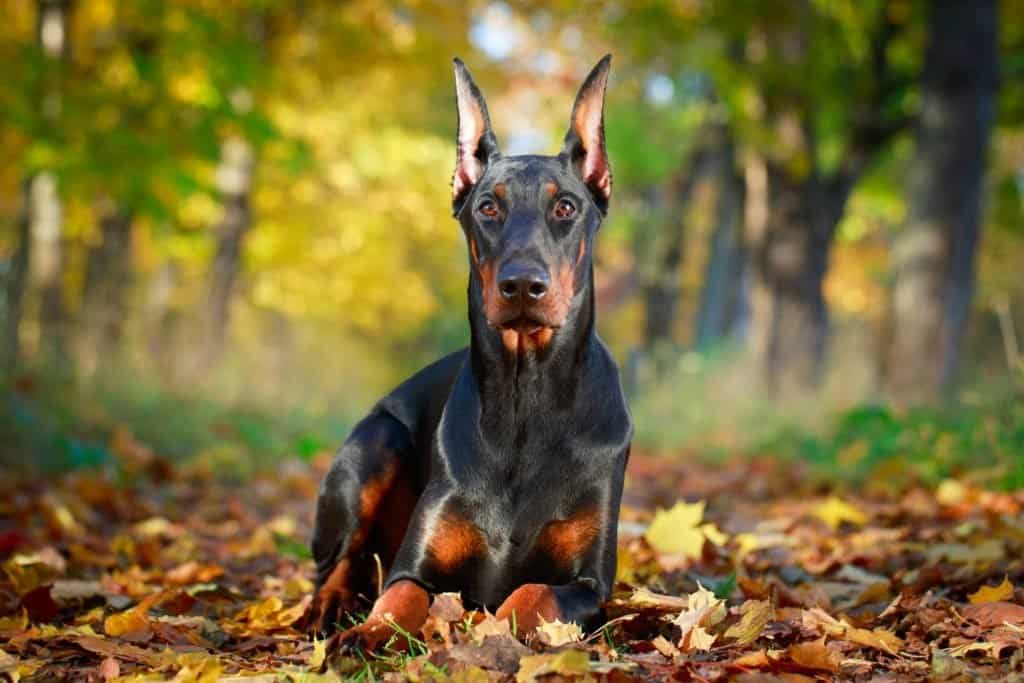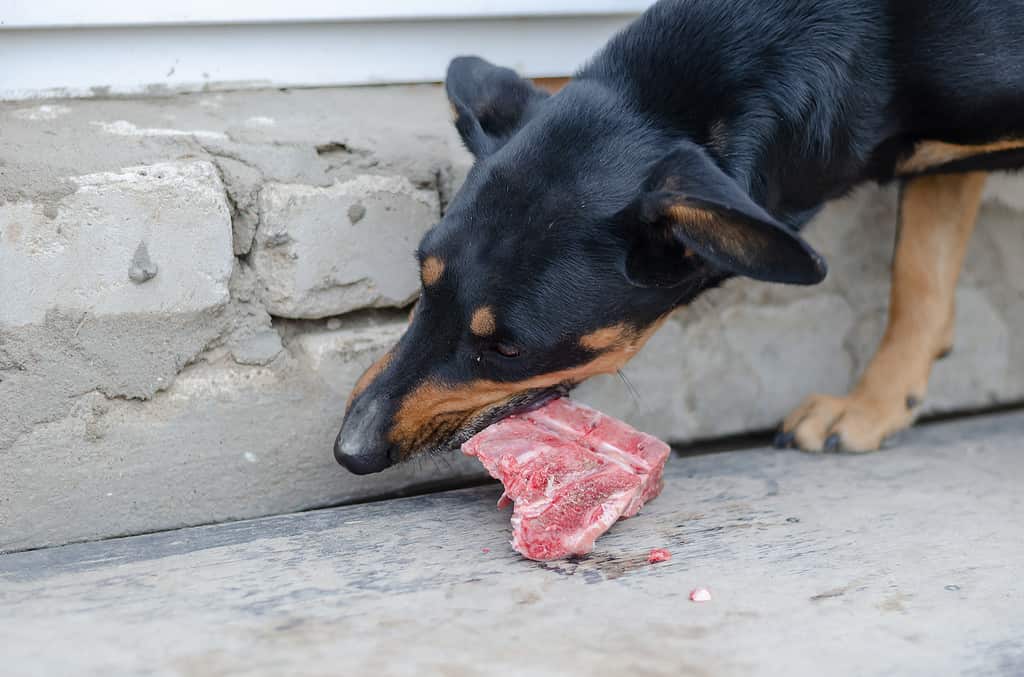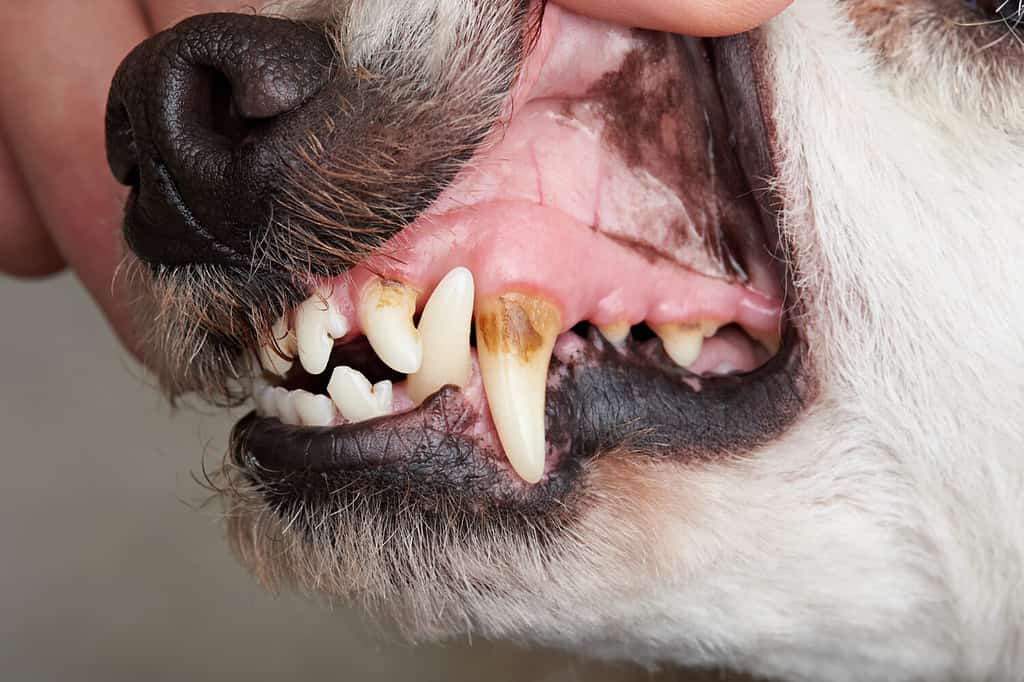One of the worst parts about owning a dog is its lifespan — no matter which breeds you choose, their lifespan can never compete with that of a human’s. While a Doberman pinscher’s lifespan ranges on the mid- to high-end of 10 to 13 years, Dobermans can develop life-threatening health problems like any other breed.
AZ Animals consulted with several veterinarians to discern the nine most common health problems for Doberman pinschers. Keep reading to discover the common health problems of a Doberman pinscher and the preventative measures you can take as an owner to keep your Doberman healthy.
Doberman Pinscher Summary

Loving, loyal, and protective: the Doberman Pinscher remains a family-favorite breed.
©DragoNika/Shutterstock.com
The Doberman pinscher remains a well-favored family dog — it’s a gentle giant that loves kids, acts affectionately with its family, and protects its pack from strangers or intruders. They’re a playful and active breed with high energy, adaptability, and trainability. The coat and movement of a Doberman is sleek and impressive to watch. The dog breed has recognizably high emotional and obedience intelligence and immense physical prowess — two reasons they’re bred as both military and police dogs.
According to Dr. Linda Simon MVB, MRCVS, who sits on the veterinary consult team for Fetched, an informative pet blog that is focused on health, supplements, and behavior, Dobermans have several health issues owners should stay vigilant for as their pup grows. “The Doberman is known for being predisposed to a wide number of medical issues. Purebred dogs are known for having a shallow gene pool, which means they are more likely to develop genetic medical issues. Some of the more common conditions I see in the Dobermans in my clinic include Wobblers syndrome, hip dysplasia, dilated cardiomyopathy and Von Willebrand’s Disease (vWD).”
10 Most Common Health Problems in Doberman Pinschers

A Doberman pinscher has predispositions for several diseases, like dilated cardiomyopathy.
©iStock.com/Mikhail Dmitriev
When consulted, the majority of the experts AZ Animals conferred with cited dilated cardiomyopathy as the most significant health issue in the breed with fatal consequences. The other illnesses, while dangerous, have more manageable side effects and symptoms.
Dilated Cardiomyopathy
According to the School of Veterinary Medicine of the University of Minnesota, as many as 58% of Dobermans will develop dilated cardiomyopathy (DCM) in their lives. DCM may present in different ways, like enlarged heart ventricles, arrhythmias, and/or heart muscle dilation. Unfortunately, DCM is a fatal genetic heart disorder. Because the disorder negatively affects how the heart muscles contract, it can lead to congestive heart failure and — sometimes more commonly — sudden death in adult Doberman pinschers.
“Without a doubt the thing that is shortening the lifespan of Dobermans the most in the last 20 years is dilated cardiomyopathy. Now Dobermans at the age of four to five years old are dropping dead with seemingly no warning. This is why Holter monitors and echocardiograms are required yearly for Dobermans over the age of two years old. This is also another reason why ethical breeding is so important, because ethical breeders will show you all of these tests before any breeding takes place on any litter. Having been in cardiac ultrasound for 14 years and now running a Heart Clinic for the Salt Lake Doberman Pinscher Club, even though we see every breed, it is the most deadly threat,” said April Dawn Niemann, RDCS, RVT.
Hip Dysplasia
About seven percent of Doberman pinschers suffer from hip dysplasia. In severe cases, it will cripple a dog’s legs with painful joints and lameness.
Like wobbler syndrome, this degenerative disease can affect the mobility of your Doberman. For an energetic breed that thrives with physical activity, hip dysplasia can negatively affect the quality of life for Dobermans. Early detection is essential, and owners can help their Dobermans avoid developing hip dysplasia by keeping them at a healthy weight. Joint supplements, as well as carefully exercising (not over- or under-doing it on runs and walks) will help prevent hip dysplasia too.
Von Willebrand’s Disease
Von Willebrand disease remains the most common inherited bleeding disorder in dogs, according to the Cornell University College of Veterinary Medicine. Clinical signs of the disease include skin bruising, excessive bleeding during surgery, or bleeding elsewhere on the body.
“The genetic blood disorder Von Willebrand’s Disease is seen in Doberman pinschers more than other breeds,” Dr. Paola Cuevas Moreno told AZ Animals. “Dogs with this disease are prone to excessive bleeding due to a deficiency in the von Willebrand factor, a protein necessary for platelets to stick together and form a clot. Dogs suffering from this condition may have spontaneous bleeding from the nose, gums, and vulva. They will also have issues with injuries or surgery because anything that will easily be resolved in other dogs is likely to cause them prolonged bleeding.
Dr. Paola Cuevas Moreno continued, stating “This is why many vets will require a Doberman to be screened before any planned surgery. A preliminary test called buccal mucosal bleeding time measures how long it takes for a small cut in the mouth to stop bleeding. If the first step indicates prolonged bleeding times, the levels of von Willebrand’s factor in blood should be measured to confirm the diagnosis.”
Wobbler Syndrome
Wobbler syndrome affects large and giant breeds (like Dobermans) and describes a set of conditions that impact the cervical spine in these breeds. Along with the Doberman, breeds like the Rottweiler, Irish wolfhound, and Great Dane suffer from wobbler syndrome.
The most common type of wobbler syndrome seen in Doberman pinschers is the type caused by a chronic bulging intervertebral disc. This disc puts pressure on the base of the spinal cord — causing the dog to take “floating” steps with their front legs and “wobbly” steps with their back legs.
Bloat
Bloat in Dobermans is an emergency whenever it occurs. It can half the blood flow to vital organs like the intestines and result in death if not properly cared for.
“Gastric dilation volvulus or bloat is a life-threatening situation in which the stomach fills up with gas and rotates within its axis obstructing the digestive flow on both the pyloric and esophageal sides,” informed Dr. Paola Cuevas Moreno, Veterinarian, MVZ, and behaviorist. “The gas will continue to cause the stomach to further expand and this will obstruct the blood flow of organs within the cavity.”
According to Dr. Cuevas Moreno, this condition requires emergency surgery and is considered very dangerous. Eating or drinking too fast, eating very large meals, or exercising right after a meal seems to increase Dobermans’ risk of developing this condition.
Cataracts
While many old dogs develop cataracts later in life, Doberman pinschers inherit the defect to develop posterior capsular cataracts after cataract surgery according to Dr. Michael Richards, DVM. This type of cataract (also termed “secondary cataract”) occurs when the artificial lens implanted during cataract surgery clouds.
Dogs, including Dobermans, can live with cataracts and enjoy a full life, but it will take adaptations if cataracts progressed so far that the dog has lost their sight.
Dental Diseases

Doberman pinschers can develop dental diseases, as well as fractured teeth thanks to their rough play.
©PixieMe/Shutterstock.com
Like many other breeds, Dobermans need consistent and thorough dental care to avoid contracting gingivitis and other dental diseases. As early as two years old, tartar can build up on teeth, infect the gums, and make things like eating and playing with toys painful. Periodontal disease is a common issue among Dobermans, as well as other small, medium, and large-sized dogs.
Dobermans also may suffer from fractured teeth if they chew on hard objects like ice cubes, bones, antlers, and animal hooves often. If your Doberman has a fractured tooth with the pulp (center of the tooth) exposed, you must consult a vet as soon as possible to remove or extract it.
Copper Hepatopathy
Dobermans have the predisposition for contracting copper hepatopathy thanks to a mutation of the ATP7B gene. This health condition, caused by the pathologic accumulation of copper in the liver, may have several different causes outside of breed predisposition. While most Dobermans and affected dogs look healthy for years before diagnosis, some clinical presentations of copper include increased liver enzymes in bloodwork, anorexia, lethargy, or hepatic failure (in advanced cases).
Experts Adrian Tinoco-Najera and Jonathan A. Libury theorized that commercial dog food’s levels of copper contributed to the prevalence of the disease over the last 30 years.
Glomerulonephritis
This kidney disease may be a harbinger for another disease. Caused by the inflammation of the glomeruli in the kidney, immune complexes get trapped with glomeruli and instigate immune responses that further damage the small structures. If caught early enough, veterinarians can treat symptoms and identify the underlying issue. Unfortunately, the vast majority of glomerulonephritis cases fail to find an underlying disease and therefore lead to death.
Progressive Retinal Atrophy
Progressive retinal atrophy (PRA) isn’t painful, but does lead to blindness in dogs. Dobermans are among the breeds that tend to inherit some eye problems and PRA is one of them. Because PRA is painless, owners may struggle to see early signs. One of the symptoms to watch out for is your Doberman struggling to move around at night. If they’re bumping into things, trip over toys clearly in their path, or don’t want to move around, it may be because they can’t see well in the dark. Other clinical signs may include:
- Cataract development.
- Abnormal reflection of light in the eyes.
- Dilated pupils.
- Hesitance to go downstairs, enter a dark room, or go outside at night.
Preventative Care for Your Doberman Pinscher

Taking care of your Doberman pinscher includes caring for dental health, hips and joints, and annual checkups.
©Moskvina Olga/Shutterstock.com
While Doberman pinschers have the proclivity to contract some life-threatening diseases, owners can do their part to create a happy and healthy existence for their dogs by practicing preventative measures.
Dental Health Is Imperative
Did you know that by age two, over 80% of dogs contract some sort of dental disease?
Caring for your Doberman’s mouth remains simple enough: clean their teeth at least once a week, whether that’s brushing their teeth or giving them teeth-cleaning treats. Because Dobermans fall within the working group and enjoy playing rough, they may have a bit too much fun and accidentally break or chip a tooth. Do your part to protect their teeth by avoiding chew hooves, ice cubes, and tough bones.
Stay Up-To-Date with Vet Checkups and Vaccines
Whether you get your Doberman pinscher puppy from a reputable breeder or rescue them, there’s a high chance they’ll have some sort of parasite or worm at first. Visit the vet before introducing them to your other pets and keep up to date with both vaccines and preventative medicine like flea, tick, and heartworm medication.
After a Doberman’s puppy years, they should visit the vet at least once a year. Dr. Sabrina Kong, DVM of WeLoveDoodles.com, asserted that “Doberman owners must be vigilant, schedule regular veterinary check-ups, and be proactive in their pet’s health. Early detection and intervention can make all the difference in managing these conditions, ensuring these loyal dogs lead a full and healthy life.”
Annual checkups work well to prevent advanced diseases, intercept infections, and provide instruction for better food, exercise, training, or treats. Your vet also knows the risks associated with the common health problems listed above and will keep their eye out for warning signs.
Satisfy Their Mental and Physical Needs
Dobermans are a smart, energetic breed with high mental stimulation needs. If your Doberman doesn’t get the exercise they need (for both their mind and their body), they can develop destructive behaviors including eating “weird” things (e.g. carpets, the floor, doors) that may cause unintended gastrointestinal complications. Another issue with lack of physical activity present in all dogs is obesity. Your Doberman may become obese if they receive more food or treats than they need and less-than-average exercise.
Protectors Need Protection, Too!
Dobermans spend their lives caring for and protecting their family — and their owners should do the same! If your Doberman pinscher begins to act strangely, seems to have something bothering them, or hasn’t been to the vet in a while, consider making an appointment to check in on their health. With the variety of blood, spine, dental, and eye problems the breed can have, you and your vet may end up finding evidence of an issue — and solve it — before you would have noticed otherwise.
The photo featured at the top of this post is © SasaStock/Shutterstock.com
Ready to discover the top 10 cutest dog breeds in the entire world?
How about the fastest dogs, the largest dogs and those that are -- quite frankly -- just the kindest dogs on the planet? Each day, AZ Animals sends out lists just like this to our thousands of email subscribers. And the best part? It's FREE. Join today by entering your email below.
Thank you for reading! Have some feedback for us? Contact the AZ Animals editorial team.







